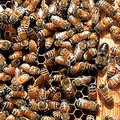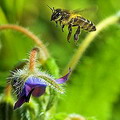 蜜蜂專家們6月26日向美國國會小組表示,美國境內的蜜蜂正以驚人速度消失,而研究員也都努力地想找出蜜蜂減少的真正原因。
蜜蜂專家們6月26日向美國國會小組表示,美國境內的蜜蜂正以驚人速度消失,而研究員也都努力地想找出蜜蜂減少的真正原因。
美國的養蜂人2008年損耗了36%的蜂群,如此破紀錄的損耗率是平常一般冬天的二倍,因此他們也提出警告,蜜蜂無故莫名的消失可能引發嚴重的環境及經濟後果。
美國養蜂聯合會副主席曼德斯(David Mendes)表示:「這不只是單純的養蜂問題而已,一定有某種造成蜜蜂生病的環境因素存在。」蜜蜂專家對眾議院園藝與有機農業小組委員會表示,這不僅僅是產值150億的蜜蜂產業所正面臨危機,美國有1/3的農作物,包括大部分的水果和蔬菜,都必須仰賴商業蜜蜂來傳播花粉。
糧食的價格已經因為高燃料價格以及中西部這幾個禮拜以來的洪災影響而高漲,現在因為健康蜜蜂的減少,糧價可能越漲越高。
沒有蜜蜂,就沒有農收
來自北卡羅萊納州的農民愛德華指出,蜜蜂對於農作物而言就如同水和陽光一樣的重要,少了蜜蜂,他的黃瓜收成被迫減少一半,因此「沒有蜜蜂,就沒有收成」。
研究員將這些問題稱之為「蜂群崩壞症候群」(colony collapse disorder, CCD),綜合特徵就是一個蜂群突然之間完全崩解。如果在某個蜂群中即便只有有少數或任何蜜蜂死亡,對養蜂人和研究員來說都是相當令人沮喪的。
「蜂群崩壞症候群」於2006年底首次受到確認,但人們迄今都還是無法解開蜜蜂神祕消失之謎。而最新的調查所提供的證據顯示,這種情況在美國越來越嚴重了,2008年蜜蜂損耗率達36%,比一年前的31%來得更高。
加州的商業養蜂人歌德林(Steve Godlin)表示,我們有時會面臨艱困的時刻,也必須承受比平常更多的損失,蜜蜂的世界在歷史上也曾發生過幾次流行病,但都沒有像我們現在所面臨的這麼嚴重。
殺蟲劑可能是罪魁禍首
對此,研究員也不斷的研究造成蜜蜂消失可能的起因,包括病毒、寄生蟲、環境面和運輸 的壓力、營養不良和殺蟲劑等。曼德斯指出,這些因素都有可能造成蜜蜂消失,但是越來越多的養蜂人都相信殺蟲劑是最主要的罪魁禍首。
晚近推出的新型「菸鹼類殺蟲劑」,最為人所知的即是影響昆蟲的免疫系統及神經系統,這種殺蟲劑會擾亂昆蟲的餵養行為並造成記憶力喪失,曼德斯向小組委員會成員表示,「這就是我們目前在蜂巢中所看到的,而令人挫折的是,肇因跟結果看起來似乎是不同的二件事」。
因為他們沒有立即的關聯性,對此,曼德斯也提出解釋,殺蟲劑不會殺死蜜蜂成蟲,但卻會折損牠們的免疫系統,而且蜜蜂會把殺蟲劑中的化學成分帶回蜂巢,將受到汙染的花粉餵食給蜜蜂幼蟲。
「 你可能在3月或4月時看到蜜蜂還好好的,但到了10月,他們可能就消失不見了!」曼德斯說。
你可能在3月或4月時看到蜜蜂還好好的,但到了10月,他們可能就消失不見了!」曼德斯說。
曼德斯和幾個養蜂人一起,從他自己的蜂窩中收集了蜜蜂樣本、蜂巢、花粉和蜂蜜等來進行測試,每次要收集這些材料、每個蜂巢都必須經歷10個月的時間,而他的測試也顯示出殺蟲劑所造成的不良影響比想像出高很多。
曼德斯向小組委員會表示,「我從2007年著手從事這個研究,到目前為止,18個蜂巢中只有4個在歷經10個月之後還能存活;而在倖存的4個蜂巢中只有1個有足夠的力量在2月為加州的杏樹傳授花粉。」
美國遲遲無法禁用殺蟲劑
曼德斯並補充,基於菸鹼類殺蟲劑可能造成蜂群崩壞症候群,德國從5月開始禁用此類殺蟲劑,但美國管理者仍缺乏足夠證據做出同樣決策。
美國最大的藍莓供應商總裁傅拉那根(Ed Flanagan)敦促國會議員留意曼得斯和其他養蜂人所提出的警告,並予以這些觀察證據更高關注。
賓州州立大學研究人員費萊瑟(Maryann Frazier)也同意,菸鹼類殺蟲劑可能是造成蜂群崩壞症候群的其中一項原因。
費萊瑟向議員解釋:「過去,人們已瞭解殺蟲劑對蜜蜂的毒害有致死危險,知道蜜蜂接觸殺蟲劑和蜂窩前大量死亡的蜂群有所關聯;但如今,我們才漸漸意識到殺蟲劑的『半致命性』毒害:不會造成蜜蜂立即死亡,但會造成某些行為障礙和降低免疫能力。」
美國農業部(USDA)一位高級官員警示,仍需要更多證據才足以判定殺蟲劑是造成蜂群繃崩壞的原因。
USDA農業研究部官員倪布林(Edward Knipling)指出,目前的研究認為蜂群崩壞症候群「並非由單一因素造成,而是許多原因相互作用於蜂群的壓力」,且無法證實殺蟲劑為其中一項原因。
他並表示,農業研究部2007年在蜜蜂研究投入600萬美元經費,並要求在2009會計年度增加78萬美元預算。儘管如此,批評者認為預算仍未反應出問題的急迫性。
冰淇淋商聲援 幫幫蜜蜂
蜂群崩壞症候群已刺激數家公司撥款支持相關研究,例如冰淇淋龍頭業者喜見達(Häagen-Dazs)已發起一項「幫助蜜蜂」活動,承諾挹注25萬美元支持授粉研究。
以天然原料生產保養用品的蜜蜂爺爺(Burt’s Bees),其公司總裁也現身公聽會促請聯邦政府提供更多資助。蜜蜂爺爺已展開一項公共服務活動,對消費者宣導蜂群崩壞症候群,並承諾捐出部份盈餘支持蜜蜂研究。
曼德斯催促農業部盡快提出一份通盤計畫,全國性採樣蜂窩,檢測殺蟲劑殘留;他認為,期待養蜂人承擔相關研究的財務重擔,根本是不切實際且不公平的。
Honeybees are vanishing at alarming rates across the United States and researchers are struggling to pinpoint the exact cause of the decline, experts told a Congressional panel Thursday.
U.S. beekeepers have lost a record 36 percent of their colonies this year, about twice the amount lost during a typical winter, and they warn that the mysterious disorder afflicting the bees could have serious environmental and economic consequences.
"This is more than just a beekeeping problem," said David Mendes, vice president of the American Beekeeping Federation. "There is something in the environment that is making our bees sick."
It is not just the $15 billion honeybee industry that is at risk, the House Agriculture Subcommittee on Horticulture and Organic Agriculture was told. A third of U.S. crops, including most fruits and vegetables, rely on the commercial bees for pollination.
Food prices, already rising due to high fuel prices and weeks of Midwest floods, are likely to rise even higher with the scarcity of healthy bees.
"Bees are as important to our crops as the water and sunshine," said North Carolina farmer Robert Edwards, who said the lack of bees has forced him to cut his cucumber crop in half. "No bees, no crops."
Researchers have labeled the problem colony collapse disorder, CCD, a syndrome characterized by the sudden and complete collapse of a bee colony. Frustratingly for beekeepers and researchers, few if any dead bees are found at the colony.
CCD was first identified in late 2006, but efforts to unravel the mystery have provided no definitive answers to date. The latest survey provides evidence it is getting worse in the United States - the 36 percent losses reported this year are up from 31 percent a year ago.
"We have had rough years from time to time with higher than usual losses, and in history there have been a few epidemics in the bee world," said Steve Godlin, a California commercial beekeeper. "But nothing has been on the levels we are facing now."
Researchers are studying possible causes including viruses, parasites, environmental and transport stresses, poor nutrition and pesticides.All of these factors may be contributing, Mendes said, but a growing number of beekeepers believe pesticides are the main culprit.
Relatively new nicotine-based pesticides are known to affect the immune and nervous systems of insects, disrupting feeding behavior and causing memory loss.
"That is what we are seeing in our hives," Mendes told members of the subcommittee. "The frustrating thing is the cause and effect seem separate.
They don't come apart right away." The pesticides do not kill the adult bees, he explained, but compromise their immune systems. The adult bees also carry the chemicals back to the hive, where they contaminate pollen fed to developing bees.
"You could be exposed in March or April and your bees look fine," Mendes said. "But come October ?they are coming apart."
Mendes is one of several beekeepers who has collected samples of bees, comb, pollen and honey from his hives for testing, gathering the material each time each hive was moved during a 10 month period. The samples tested showed much higher levels of pesticides than expected, he said.
"Of the 18 hives that began this study in March 2007, only four of these hives were still alive 10 months later," Mendes told the panel. "Of these four hives only one was of sufficient strength to pollinate almonds in California in February."
Germany last month banned a nicotine-based pesticide due to concern the chemical was causing CCD, said Mendes, but U.S. regulators lack the data to make such a decision.
Flanagan urged the lawmakers to heed warnings sounded by Mendes and other beekeepers and to give their anecdotal evidence greater weight.
Maryann Frazier, a researcher at Pennsylvania State University, agreed pesticides are likely to be at least one factor contributing to CCD.
"In the past, pesticide poisoning of honey bees has been associated with lethal exposure and the obvious symptom of a pile of dead bees in front of the hive," she told the subcommittee. "We are becoming increasingly concerned that pesticides may affect bees at sublethal levels, not killing them outright, but rather impairing their behaviors and their abilities to fight off infections."
A top official with the U.S. Department of Agriculture, USDA, research division cautioned that more research is needed before pesticides can be blamed for the disorder.
Research suggests CCD is "caused by an interaction of multiple factors stressing the colony rather than a single cause" and has yet to confirm an association with pesticides, said Edward Knipling, administrator of the U.S. Department of Agriculture's research division.
He said the Agricultural Research Service spent some $6 million on honeybee research last year and has requested an additional $780,000 for fiscal year 2009.
Critics contend that sum does not reflect the urgency of the problem.
The worry about colony collapse disorder has also prompted several companies to funnel money into researching the issue. Ice cream giant Häagen-Dazs, for example, has launched a "Help the Honey Bees" campaign and pledged $250,000 to fund pollinator research.
The head of Burt's Bees, which manufactures personal care products from natural ingredients, also appeared at the hearing to urge for more help from the federal government.
The company has started a public service campaign to inform consumers about CCD and pledged to donate some of its profits to fund bee research.
Mendes urged USDA officials to devise a comprehensive program to sample hives across the nation and to test them for pesticides, arguing it is unfair and unrealistic to expect beekeepers to shoulder the financial burdens of researching the disorder.
全文及圖片詳見:ENS




